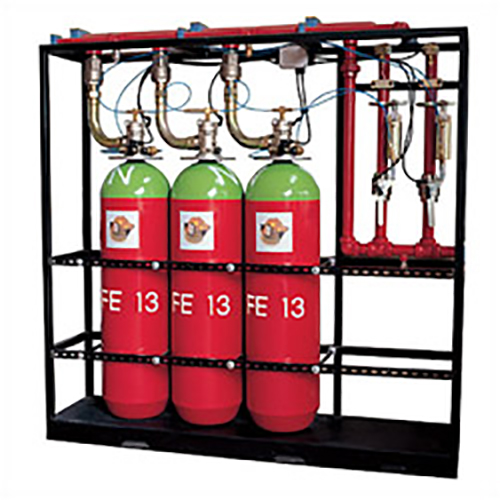
Description and Applications
The extinguishing systems in chemical gas HFC-23 (FE 13 ®) – Trifluoromethane (CHF ³) are considered of clean agent systems, the law that oversees the use of this extinguisher is the NFPA 2001, ISO 14520 – 10 and the UNI 10877/10. A difference of Halon 1301 which intervened on the fire by chemical means, the extinguishing HFC-23 extinguishes the fire by reducing the flame temperature below the level needed to maintain combustion, since it reduces the oxygen concentration, and increasing the thermal capacity of the air.
The principle of operation of HFC-23 is that of saturation of the environment (total flooding); this system of operation has the great advantage of not having to worry about the location of the risk materials, nor of its shape because, creates conditions homogeneous throughout the environment. As a result of the descending air mixtures – extinguishing agent is important to indicate the maximum height at which you can find combustible materials covered by the security.
Another essential parameter is the evaluation of the volume to be protected in order to fix the amount of gas to be used. The characteristics of the environment to be protected are fundamental for a correct design of the system, so that the NFPA expressly provides leak test the Door Fan Integrity Test, and the closure of all openings with automatic frames and the immediate stop Ventilation systems are critical to the effectiveness of the system.
In particular small areas where there are numerous openings more or less sealed, where can exit the extinguishing gas, it is common to use double release systems. After the first download, follows a download additional “maintenance ” which adds the gas that is lost through the openings so as to maintain the concentration on the parameters required for shutdown.
With regard to the limits of concentration and exposure of humans to the smothering gas HFC-23 is made to the U.S. EPA (Environmental Protection Agency) and the Protocol of Reinhardt.
For an assessment of the compatibility of HFC-23 with the environment must consider the interaction determines that the gas in contact with the flame and the resulting products of the chemical decomposition. The HFC-23 in fact to the contact with the flame and the heat produces hydrofluoric acid (HF) in varying amounts in accordance with the parameters used for the application and is therefore recommended the adoption of breathing apparatus for the intervention in environments so ; protected.
The proliferation of new type of clean agent fire extinguishing gas Inert gas Haloncarbons and led the NFPA 2001 to introduce a new testing protocol compatibility of the toxicological called PBPK – Physiologically Based Pharmacokinetic model, which considers the maximum permissible concentration in the blood of ‘ extinguishing agent and the time needed to reach it.
This extinguisher is suitable for the protection of those at risk of fire class A containing combustible materials such as wood, paper, plastics, etc.. Typical installations are in the protection of computer centers electronic and telecommunications equipment or high-value items in museums or archives.
In summary the system gas extinguishing HFC-23 is constituted by a storage (cylinders) under pressure connected through valves to a system of pipes that deliver to destination (collector and distribution piping). The extremity of said pipes there are nozzles through which the gas is discharged onto the compartment or object to be protected.


